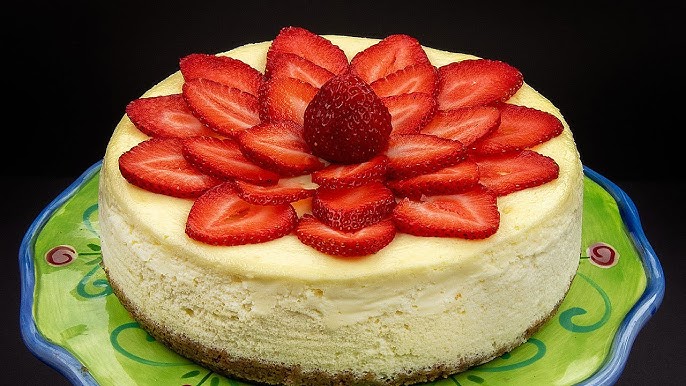Philadelphia Cream Cheese Cheesecake Recipe: Is there anything more indulgent and universally adored than a classic, creamy cheesecake? Whether you’re celebrating a birthday, hosting a dinner party, or simply craving a slice of sweet satisfaction, nothing hits the spot like a smooth and rich Philadelphia Cream Cheese Cheesecake. Known for its iconic texture and flavor, this recipe is a must-have in every dessert lover’s arsenal.
Philadelphia cream cheese has long set the benchmark for cheesecakes, offering a smooth consistency and rich taste that’s tough to beat. This guide walks you through each step of the process—from preparing the crust to serving the finished masterpiece—with pro tips sprinkled in to help you create a dessert that looks and tastes like it came straight from a professional bakery.
Ingredients You’ll Need
Before diving into the method, let’s get everything in order. Here’s what you’ll need for both the crust and the filling:
For the crust
- 1 ½ cups graham cracker crumbs (about 12 full crackers)
- ¼ cup granulated sugar
- ½ cup melted butter (unsalted)
This classic graham cracker crust provides a crunchy, buttery base that perfectly complements the creamy filling.
For the cheesecake filling
- 4 packages (8 oz each) Philadelphia Cream Cheese, softened
- 1 cup granulated sugar
- 1 tsp pure vanilla extract
- 4 large eggs
- 1 cup sour cream (optional for added creaminess)
- 2 tbsp all-purpose flour (optional for a firmer texture)
The combination of these ingredients creates a cheesecake that’s tangy, sweet, and wonderfully smooth.
Kitchen Tools Required
To get started, you’ll want to have these tools handy:
- Springform pan (9-inch)
- Mixing bowls (various sizes)
- Electric mixer or stand mixer
- Rubber spatula
- Measuring cups and spoons
- Cooling rack
- Aluminum foil (for water bath baking method)
- Roasting pan (for water bath)
Having the right tools makes this process so much easier and cleaner.
How to Make Philadelphia Cream Cheese Cheesecake Recipe – Step by Step Guide
Step 1: Preparing the crust
Start by preheating your oven to 325°F (163°C). In a mixing bowl, combine the graham cracker crumbs, sugar, and melted butter. Mix until the crumbs are fully coated and look like wet sand. Press this mixture firmly into the bottom of your springform pan. Use a flat-bottomed cup or spoon to make sure the crust is even and compact.
Bake the crust for 10 minutes. This step helps to set the base and gives it a nice toasty flavor. Let it cool while you prepare the filling.
Step 2: Mixing the cheesecake filling
Make sure your cream cheese is at room temperature to avoid lumps. Beat the softened cream cheese in a large mixing bowl until smooth and creamy—about 2 to 3 minutes. Add sugar and continue beating until well combined.
Now, mix in the vanilla extract. Add the eggs one at a time, beating just until each is incorporated. Don’t overmix at this stage—it can introduce too much air, leading to cracks during baking. If using sour cream and flour, gently fold them in now with a spatula.
Step 3: Pouring and smoothing
Pour the filling over the cooled crust in the springform pan. Tap the pan gently on the counter to release any air bubbles. Use a spatula to smooth out the top.
If you’re using a water bath (highly recommended for even baking), wrap the bottom of the pan in aluminum foil and place it in a large roasting pan. Fill the pan with hot water halfway up the sides of the springform.
Step 4: Baking to perfection
Bake for 55 to 70 minutes, or until the center is almost set but still slightly jiggly. Turn off the oven, crack the oven door, and let the cheesecake cool in the oven for 1 hour. This helps prevent sudden temperature changes that can cause cracks.
Once it’s done cooling, remove it from the water bath and allow it to come to room temperature.
Step 5: Cooling and chilling
After it has reached room temperature, refrigerate the cheesecake for at least 4 hours, but ideally overnight. This sets the texture and enhances the flavor.
Tips for the Perfect Cheesecake
Making the perfect cheesecake is a blend of science and art. While the recipe is straightforward, a few insider tricks can elevate your results from good to bakery-level amazing.
First, always ensure all your ingredients—especially the cream cheese, eggs, and sour cream—are at room temperature before you start mixing. Cold ingredients won’t blend smoothly and may result in a lumpy batter. Soft cream cheese is key to that velvety texture we all crave in a cheesecake.
Second, don’t rush the mixing process. Beat the cream cheese thoroughly before adding any other ingredients, but once you start adding eggs, mix on low speed and only until just combined. Overmixing can cause too much air to get trapped in the batter, leading to cracks as it bakes.
Third, use a water bath. Yes, it’s an extra step, but it’s worth it. A water bath helps regulate the temperature around the cheesecake, preventing it from cooking too quickly or unevenly. Just make sure the foil around the pan is tightly sealed to keep water out.
Finally, let your cheesecake rest after baking. Turn the oven off, crack the door, and let it cool slowly inside for about an hour. This gradual temperature change prevents the top from cracking. Once out of the oven, let it cool completely before placing it in the fridge overnight. The longer it chills, the better it tastes.
Variations You Can Try
Want to mix things up? This Philadelphia Cream Cheese Cheesecake is a solid base for a variety of creative spins. Here are a few delicious ideas to experiment with:
- Chocolate Swirl Cheesecake: Melt some semi-sweet chocolate chips and swirl the chocolate into the cheesecake batter before baking for a marbled effect. You can also add a chocolate cookie crust instead of graham crackers for extra richness.
- Berry Topped Cheesecake: Add a homemade or store-bought berry compote on top after the cheesecake has cooled. Strawberries, raspberries, blueberries, or a mix of all three can add a tart contrast to the sweet, creamy base.
- No-Bake Version: Don’t want to deal with the oven? You can make a no-bake version by skipping the eggs and adding some gelatin or whipped cream to help the filling set. It’s lighter and quicker—perfect for hot summer days.
- Pumpkin Cheesecake: For a fall twist, blend in 1 cup of pumpkin puree and a teaspoon of pumpkin spice with the cream cheese mixture. It’s a festive take that’s a huge hit during Thanksgiving.
- Mini Cheesecakes: Use a muffin tin and cupcake liners to create individual-sized cheesecakes. They’re fun for parties and easier to serve.
These variations can be tailored to any season, event, or personal taste, making this recipe endlessly versatile.
How to Serve Philadelphia Cheesecake
Presentation makes a big difference, especially if you’re serving guests. Cheesecake is naturally beautiful with its glossy, creamy top and golden crust, but a few finishing touches can elevate it even more.
Cut the cheesecake with a long, sharp knife dipped in hot water and wiped clean between each slice. This ensures smooth, clean edges without the filling sticking to the blade.
For garnishing, try any of the following:
- Fresh berries and a dusting of powdered sugar
- Shaved chocolate or cocoa powder
- Whipped cream swirls with a cherry on top
- A drizzle of caramel or chocolate sauce
- Lemon zest for a citrusy note
Serve your cheesecake slightly chilled, but not ice cold—letting it sit out for about 10 to 15 minutes before slicing helps bring out the full flavor and creamy texture. Pair it with a cup of coffee, espresso, or even a dessert wine for the ultimate indulgence.
Storing and Freezing Tips
Cheesecake is a make-ahead dream and stores wonderfully if handled correctly.
In the fridge: Once cooled and set, cover your cheesecake with plastic wrap or foil and store it in the refrigerator for up to 5 days. Make sure it’s sealed tightly to prevent it from absorbing fridge odors.
In the freezer: To freeze, wrap the entire cheesecake or individual slices tightly in plastic wrap, then again in aluminum foil, or place it in a freezer-safe container. Cheesecake can be frozen for up to 2 months without losing flavor or texture. When ready to serve, thaw it overnight in the fridge. Do not thaw at room temperature as that could cause the texture to break down.
Pro tip: If you’re freezing slices, place a piece of parchment paper between them to prevent sticking.
Common Mistakes and How to Fix Them
Even seasoned bakers run into trouble with cheesecake. The good news? Most issues are avoidable—and even fixable—with the right knowledge. Here are some of the most common mistakes people make with Philadelphia cream cheese cheesecake, and how you can steer clear of them.
1. Lumpy Batter
If your batter isn’t smooth, it’s usually because the cream cheese wasn’t softened properly. Always bring it to room temperature before mixing. Cold cream cheese clumps and is difficult to blend. If you do get lumps, you can try straining the batter through a fine mesh sieve, but prevention is best.
2. Overmixing the Batter
Once you add the eggs, overmixing introduces air, which causes your cheesecake to puff up during baking and then collapse or crack as it cools. Use a low speed and mix only until each egg is just incorporated. You want your batter smooth but not frothy.
3. Cracks on Top
Cracks are usually caused by overbaking or sudden temperature changes. To prevent this, use a water bath, don’t overbake, and let the cheesecake cool gradually. Even if you do get a few cracks, don’t worry—they won’t affect the taste, and you can always cover them with toppings.
4. Undercooked Center
A perfectly baked cheesecake should have a slightly jiggly center when it comes out of the oven. If it’s too jiggly or looks wet, it needs more time. Resist the urge to bake until it’s firm—this will overcook the edges. Use a thermometer if needed; the center should reach about 150°F (65°C).
5. Removing the Cheesecake Too Soon
Taking your cheesecake out of the pan before it’s fully set can ruin its shape. Always cool it completely and chill for several hours—or overnight—before attempting to remove it from the springform.
By keeping these pointers in mind, you’ll save yourself from disappointment and ensure your cheesecake comes out looking as good as it tastes.
Nutritional Information
Wondering what’s in each slice of this heavenly dessert? Here’s a general breakdown for a standard 9-inch cheesecake (divided into 12 slices):
| Nutrient | Per Slice (approx.) |
|---|---|
| Calories | 430–500 kcal |
| Total Fat | 35g |
| Saturated Fat | 20g |
| Cholesterol | 120mg |
| Sodium | 300mg |
| Carbohydrates | 30g |
| Sugar | 25g |
| Protein | 6g |
Note: This can vary depending on optional ingredients like sour cream or toppings.
While cheesecake isn’t exactly a health food, it’s meant to be savored in moderation. It’s rich, satisfying, and ideal for special occasions or whenever you need a sweet pick-me-up. If you’re watching your intake, you can experiment with light cream cheese, sugar substitutes, or smaller serving sizes.
FAQs about Philadelphia Cream Cheese Cheesecake Recipe
1. What ingredients do I need for a Philadelphia Cream Cheese cheesecake?
To whip up a classic Philadelphia Cream Cheese cheesecake, you’ll need: Philadelphia Cream Cheese (of course!), granulated sugar, eggs, vanilla extract, a pinch of salt, and a crust—usually made from graham crackers, butter, and sugar. Some recipes might also call for sour cream or heavy cream for extra creaminess.
2. How long does it take to make a Philadelphia Cream Cheese cheesecake?
Patience is key! The total time is about 4 to 5 hours, including preparation and cooking. Most of that time is the cheesecake chilling in the fridge, which is crucial for achieving the perfect texture.
3. What’s the secret to a smooth and crack-free cheesecake?
The golden rule is to avoid overmixing and to cook your cheesecake gently. Use a water bath during baking to maintain even heat distribution and minimize surface cracking. Also, letting the cheesecake cool gradually in the oven with the door slightly open can prevent sudden temperature changes that cause cracks.
4. Can I make this cheesecake without a springform pan?
Absolutely! While a springform pan is traditional, any deep baking dish will work as long as you line it well with parchment paper for easy removal. Just be mindful that altering the pan size may impact baking time.
5. Is it necessary to use full-fat cream cheese?
For the creamiest texture, full-fat Philadelphia Cream Cheese is recommended. Lower-fat options can be used, but they might alter the richness and density of your cheesecake.
6. How do I know when my cheesecake is done baking?
The center of the cheesecake should still be slightly wobbly when you remove it from the oven. It will continue to cook slightly from residual heat and set perfectly as it cools.
7. Can I freeze Philadelphia Cream Cheese cheesecake?
Yes, cheesecake freezes exceptionally well. Wrap it tightly in plastic wrap and then in aluminum foil. Properly stored, it can last up to a month. Thaw in the refrigerator overnight before serving.
Conclusion
Philadelphia Cream Cheese Cheesecake is more than just a dessert—it’s a showstopper that brings smiles and sighs of delight with every bite. With its buttery graham cracker crust, creamy filling, and endless potential for customization, this classic treat never goes out of style. Whether you stick to the original or jazz it up with swirls, fruit, or chocolate, you’re in for a decadent dessert experience.
By following the detailed steps and tips in this guide, even beginner bakers can craft a cheesecake that rivals any bakery. So go ahead—get your ingredients ready, preheat that oven, and treat yourself (and your lucky guests) to a slice of rich, creamy bliss.



